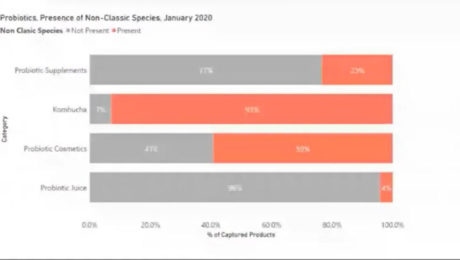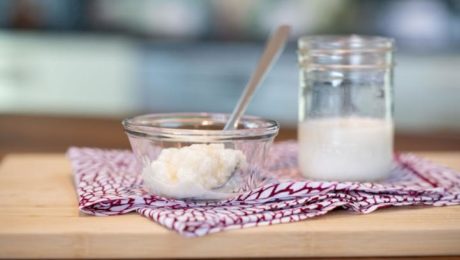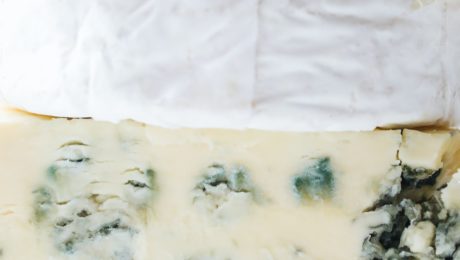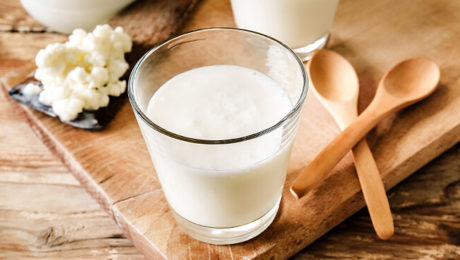New Strains Drive Probiotic Market
Kombucha and cosmetics are driving growth in the probiotic and prebiotic markets by making products that use non-classic strains of bacteria.
The e-commerce market for probiotic supplements was estimated at $973 million across 20 countries in 2020. America accounts for almost half of those sales. Ewa Hudson, director of insights for Lumina Intelligence, shared this info at the Probiota Americas 2020 Conference. (Lumina and Probiota Americas are parts of William Reed Business Media, the parent company for FoodNavigator.com.) The session, New Horizons for Prebiotics & Probiotics, included Lumina’s insight into non-classic bacteria strains and a panel discussion with leaders in the probiotics field.
In 2020, 32% of all probiotics in America — and 41% of the best-selling ones — contained non-classic species. Hudson said this species classification is a messy space, especially from a consumer’s perspective, because there are so many species. Kombucha includes the most non-classic probiotic species — of those products with probiotics, 93% include non-classic bacteria .
Most products with probiotics include one of the four common bacteria species: lactobacilli, bifidobacterium, bacillus and saccharomyces. Lumina excluded these four from their research to focus on the growth of the non-classic probiotic strains. These include: streptococcus thermophilus, kombucha culture, lactococcus lactis, bifida ferment lysate, enterococcus faecium, streptococcus salivarius, clostridium butyricum and streptococcus faecalis.
Though probiotics are often used in supplements, more fermented food and beverage manufacturers are using probiotic strains in their products, especially in the growing alternative protein market.
Synbiotics are also becoming more widely used; the study found synbiotics were the most prevalent formulate in probiotics. Synbiotics are a combination of both prebiotics and postbiotics. A synbiotic ensures that probiotics will have a food source in the gut.
(Probiotics are live microorganisms, friendly bacteria that provide health benefits. Probiotics can be found in fermented food and taken as supplements. Prebiotics are dietary fibers that feed the probiotics. Postbiotics are an emerging concept in the “biotics” space — postbiotics are the waste byproduct of probiotics.)
“With probiotics, we are really only starting to scratch the surface with the development of synbiotics,” says Jens Walter, PhD, professor of ecology, food and the microbiome at APC Microbiome Ireland.
The new generation of probiotics will depend on strains that are “efficacious in the gut,” Walter noted.
“If you look into the probiotic market, most of the lactobacillus species — and also species like bifidobacterium lactis — are not inherent organisms of the human gut. We’re using a lot of organisms that I would argue have an ecological disadvantage in the gut,” Walter says. “If you’re talking about next generation probiotics, I think what will become is we are looking for the key players in the gut, specifically key players that are underrepresented or linked to certain benefits, and then we are trying to put them back in the ecosystem.”
It’s challenging to find a prebiotic or postbiotic that is precise, he continues.
“Every human has a distinct microbiome. So it’s likely a synbiotic designed for one human may not be as functional in another human,” Walter says. “The opportunities here are tremendous.”
Daniel Ramon Vidal, vice president of research and development and health and wellness at the American food processing company Archer-Daniels-Midland (ADM), also spoke. He noted that the human body is made up of trillions of microbial cells, but we know little about these microbial worlds.
“There is an enormous amount of possibilities to isolate new strains that are living in our body,” Daniels says. “We need as much science as possible, that’s my message”
The panel agreed that postbiotics has become one of the next great concepts that scientists, manufacturers and gastroenterologists have latched onto. But consumers are not as familiar with postbiotics as they are with probiotics and prebiotics , notes Justin Green, PhD, director of scientific affairs for EpiCor, a postbiotic ingredient produced by Cargill.
“This causes more confusion, so I think that’s going to be another interesting aspect of postbiotics — both the identity of what postbiotics are and how it confers its benefits and (how that will be) communicated to the consumer,” Green says.
New Global Definition for Fermented Foods
A major scientific announcement was made this week, creating a global definition for fermented foods. A team of 13 interdisciplinary scientists (including TFA Advisory Board members Maria Marco and Ben Wolfe) spent over a year discussing the issue in order to reach a consensus. An official definition has long been debated, especially in recent years as fermentation has experienced a renaissance in the modern diet. This definition, the first of its kind, hopes to provide clarity to scientists, producers and consumers.
Below is a press release from the International Scientific Association for Probiotics and Prebiotics (ISAPP) on the definition. The full research paper was published in Nature. Marco also wrote a blog on the ISAPP website, further detailing the work that led to the definition.
Humans have consumed different types of fermented foods — from kimchi to yogurt — for thousands of years. Yet only recently, with the availability of new scientific techniques for analyzing their nutritional properties and microbiological composition, have scientists begun to understand exactly how the unique flavors and textures are created and how these foods benefit human health.
Now, 13 interdisciplinary scientists from the fields of microbiology, food science and technology, family medicine, ecology, immunology, and microbial genetics have come together to create the first international consensus definition of fermented foods. Their paper, published in Nature Reviews Gastroenterology & Hepatology, defines fermented foods as: “foods made through desired microbial growth and enzymatic conversions of food components”.
The authors take care to note the difference between probiotics and the live microbes associated with fermented foods. The word ‘probiotic’, they say, only applies in special cases where the fermented food retains live microorganisms at the time of consumption, and only when the microorganisms are defined and shown to provide a health benefit, as demonstrated in a scientific study.
“Many people think fermented foods are good for health — and that may be true, but the scientific studies required to prove it are limited and have mainly focused on certain fermented food types,” says first author Maria Marco, Professor in the Department of Food Science and Technology at the University of California, Davis.
Co-author Bob Hutkins, Professor in the Department of Food Science and Technology at University of Nebraska, Lincoln — who has authored a well-known academic textbook on fermented foods — says, “We created this definition to cover the thousands of different types of fermented foods from all over the world, as a starting point for further investigations into how these foods and their associated microbes affect human health.”
The consensus panel discussion was organized in 2019 by the International Scientific Association for Probiotics and Prebiotics (ISAPP), a non-profit organization responsible for the published scientific consensus definitions of both probiotics (in 2014) and prebiotics (in 2017).
Mary Ellen Sanders, Executive Science Officer of ISAPP, says, “To date, different people have had different ideas of what constitutes a fermented food. The new definition provides a clear concept that can be understood by the general public, industry members and regulators.”
Currently, evidence for the positive health effects of fermented foods has relied more on epidemiological and population-based studies and less on randomized controlled trials. The authors expect that, in the years ahead, scientists will undertake more hypothesis-driven research on how different fermented foods from around the globe — derived from dairy products, fruit, vegetables, grains, and even meats — affect human physiology and enhance human health.
Food and Beverage Laws Passed in 2020
Every year, the nation’s 50 state legislatures pass dozens of new laws that have an impact on fermenters. For example, some states amended alcohol laws to allow drink sampling for craft wineries, while others repealed outdated cottage food laws to help small producers operate and more loosened take-out restrictions to help small restaurants survive the pandemic.
Indicative of this year’s focus on the pandemic, laws were introduced but never debated as lawmakers focused on more pressing issues surrounding the coronavirus. The most common new laws passed in 2020 revolved around helping businesses survive — states called special sessions to aid restaurants, stop price gouging of high-demand products and provide emergency grants to small businesses.
Read on for key food, beverage and food service laws passed this year, most taking effect in 2021.
California
AB82 — Prohibits an establishment with an alcohol license from employing an alcohol server without a valid alcohol server certification.
AB3139 — Establishments with alcoholic beverages licenses who had premises destroyed by fire or “any act of God or other force beyond the control of the licensee” can still carry on business at a location within 1,000 feet of the destroyed premise for up to 180 days.
Delaware
HB 237 — Eliminates old requirements that movie theaters selling alcohol must have video cameras in each theater, and that an employee must pass through each theater during a movie showing.
HB275 — Permits beer gardens to allow leashed dogs on licensed outdoor patios.
HB349 — Permits any restaurant, brewpub, tavern or taproom with a valid on-premise license to sell alcoholic beverages for take-out or drive through food service, so long as the cost for the alcohol did not exceed 40% of the establishment’s total sales transactions.
Hawaii
SR84 — Creates a Restaurant Reopening Task Force to help restaurants in Hawaii safely reopen that were closed during the COVID-19 pandemic.
SR94 — Urges restaurants to adopt recommended best practices and safety guidelines developed by the United States Food and Drug Administration and National Restaurant Association in response to the COVID-19 pandemic.
Idaho
HB343 — Amends existing law to require licensing to store and handle wine as a wine warehouse.
HB575 — Allows sampling of alcohol products at liquor stores, which was formerly forbidden under law.
SB1223 — Eliminates obsolete restrictions on food products, to match federal standards. It repeals requiring extra labels on some imported food products, and repeals using enriched flour in bread baking.
Illinois
HB2682 — Amends Liquor Control Act of 1934. Allows a cocktail or mixed drink placed in a sealed container at the retail location to be sold for off-premises consumption if specified requirements are met. Prohibits third-party delivery services from delivering cocktails or mixed drinks.
HB4623 — Amends Food Handling Regulation Enforcement Act, regulating that public health departments provide a certificate for cottage food operations, which must be displayed at all events where the licensee’s food is being sold.
Iowa
HB2238 — Amends code regarding food stands operated by a minor. Bans a municipality from enforcing a license permit or fee for a minor under the age of 18 to sell or distribute food at a food stand.
Kentucky
HB420 — Implements Food Safety Modernization Act, authorizing a department representative to enter a covered farm or farm eligible for inspection.
SB99 — Amends alcohol laws for state’s distillers, brewers and small wineries. Eliminates the sunset on local precinct elections to grant distilleries, and allows distillers to sell other distiller’s products.
Louisiana
HR17 — Allows third-party delivery services to deliver alcohol.
HB136 — Makes adulterating a food product by intentional contamination a crime.
SB455 — Increases the size of containers of high-alcoholic beverages.
SB508 — Gives restaurants protection from lawsuits involving COVID-19. The public will be unable to sue restaurants for COVID-19-related deaths or injuries, as long as the restaurant complies with state, federal and local regulations about the virus.
Maine
LD1167 — Encourages state institutions to serve Maine food and Maine food products, increasing the visibility of the state’s local food producers.
LD1884 — Amends current laws regarding businesses that hold dual liquor licenses, which authorized retailers to sell wine for consumption both on- and off-premise. Retailers with the dual license can now sell with just one employee at least 21 years of age present, and adds that wine can be sold for take-out if food is part of the transaction.
Maryland
HB1017 — Allows cottage food businesses to put their phone number and business ID on their food label, rather than their address as currently required by the Maryland Department of Health.
SB118 — Expands definition of “alcohol production” and “agricultural alcohol production.” The new definitions aim to give Maryland farmers and producers the ability to sell beer, wine and spirits to increase agritourism.
Massachusetts
SB2812 — Expands alcohol take-out and delivery options during COVID-19 pandemic. Allows restaurants to sell mixed drinks in sealed containers alongside other take-out and delivery food orders.
Michigan
HB5343 — Revises regulations on brewpubs and microbreweries, increasing the quantity of beer a microbrewer is permitted to deliver to a retailer during a year from 1,000 barrels to 2,000 barrels.
HB5345 — Amends the Michigan Liquor Control Code to delete the Michigan Liquor Control Commission (MLCC) $6.30 tax levied on each barrel of beer manufactured and sold in Michigan.
HB5354 — Amends the Michigan Liquor Control Code to delete the requirement that a brewpub cannot sell beer in Michigan unless it provides for each brand or type of beer sold a label that truthfully describes the content of each container.
SB711 — Establishes new limited production brewer license for microbreweries at cost of $1,000 for license.
HB5356 — Amends the Michigan Liquor Control Code to ban the required $13.50 cent-per-liter tax on all wine containing 16% or less of alcohol by volume sold in Michigan.
Minnesota
HB5 — Authorizes emergency, small-business grants and loan funding for businesses affected by COVID-19.
HB4599 — Extends period of mediation for Minnesota farmers suffering economic difficulties to keep their farm.
Mississippi
HB326 — Amends outdated code to increase the maximum annual gross sales for a cottage food operation (from $20,000 to $35,000) before the producer would need to pay food establishment permit fees. Authorizes a cottage food operation to advertise products over the internet.
New Jersey
AB2371 — Requires large generators of food waste (like restaurants and supermarkets) to recycle food garbage rather than send it to incinerators or landfills.
AB3865 — Limits return of food from retail food stores during a public emergency.
SB864 — Prohibits sale of single-use plastic carryout bags, single-use paper carryout bags and polystyrene foam food service products, and limits single-use plastic straws.
SB1591 — Allows alcoholic beverages to be consumed from open containers in the Atlantic City Tourism District.
SB2437 — Limits service fees charged to restaurants by third-party food takeout and delivery applications during COVID-19 pandemic.
New Mexico
SB3 — Enacts the Small Business Recovery Act of 2020, which provides loans for small businesses suffering during the coronavirus pandemic.
New York
SB8225 — Authorizes issuing a retail license for on-premise consumption of food and beverage within 200 feet of a church, synagogue or other place of worship.
AB8956 — Allows a licensed brewery or farm brewery to provide no more than four beer samples not exceeding four fluid ounces each.
SB1472 — Requires hospitals to offer plant-based food options to patients upon request.
SB7013 — Authorizes the manufacture and sale of ice cream or other frozen desserts made with liquor.
North Carolina
SB290 — The Alcoholic Beverage Control Regulatory Reform Bills, it allows distilleries the same serving privileges as wineries and craft breweries and reduces regulation on out-of-state sales.
Ohio
HB160 — Aid for the restaurant industry to recover from COVID-19 pandemic, the bill doubles the maximum number of Designated Outdoor Refreshment Areas (DORAs) that can be created in a municipality or township. Also allows Ohio’s small wineries to sell prepackaged food without regulation from the Ohio Department of Agriculture, creates bottle limits for micro-distilleries and permits license holders to sell alcoholic ice cream.
South Carolina
HB4963 — Amends state alcohol code, allows licensed retailers to give wine samples in excess of 16% alcohol, cordials or distilled spirits, as long as they don’t exceed a total of three liters a year.
SB993 — Amends state alcohol code to allow a permitted winery to be eligible for a special permit to sell wine at off-premise events. Also increases the amount of beer a brewery can sell to an individual per day for off-premise consumption.
South Dakota
HB1073 — Authorize special event alcohol licenses for full-service restaurant licensees.
HB1081 — Allows colleges to teach brewing beer and wine classes on South Dakota campuses to students age 21 or older. Brewing must be held off campus as the education institution is not deemed a licensed manufacturer. Any distilled spirits, malt beverage, or wine produced under this section may only be consumed for classroom instruction or research and may not be donated or sold.
Tennessee
SB2423 — Allows alcohol sales at the Memphis Zoo.
SB1123 — Encourages farmers who produce raw milk to complete a safe milk-handling course.
Utah
HB134 — Legalizes the sale of raw butter and raw cream in Utah;
HB232 — An agri-tourism bill that allows farms and ranches to host events that include food that would not need to be prepared in a commercial kitchen. Farmers must apply for a food establishment permit to use their private home kitchen.
HB399 — Changes to the Alcohol Beverage Control Act, prohibits advertising that promotes the intoxicating effects of alcohol or emphasizes the high alcohol content of an alcoholic product.
HB5010 — The COVID-19 Cultural Assistance Grant Program, which appropriates $62 million for struggling arts, cultural and recreational organizations and businesses across the state.
HB6006 — In response to the coronavirus pandemic, the bill amends the Alcohol Beverage Control Act, delaying the expiration date of the retail licenses set to expire in 2020 for places selling alcohol. Also permits alcoholic beverage licensees at international airports to change locations if needed.
Vermont
SB351 — A coronavirus relief bill which authorizes $36 million for agriculture and forestry sectors.
Washington
HB2217 — An update to Cottage Food Law eliminates the requirement that a home address must be put on a food label.
HB2412 — Increases amount of additional retail licenses for a domestic brewery or microbrewery from two to four, and directs health department to adopt rules allowing brewery owners to allow dogs on brewery premise
SB5006 — Allows sale of wine by microbrewery license holders.
SB5323 — A bill eliminating single-use, plastic carry-out bags
SB5549 — Modernizing resident distillery marketing and sales restrictions. Allows distilleries to sell products off-premise, similar to breweries and wineries.
SB6091 — Continues work on the Washington Food Policy Forum, including support for small farms and increasing the availability of food grown in the state.
West Virginia
HB4388 — Removes outdated restrictions on alcohol advertising, limiting the Alcohol Beverage Control Commissioner’s authority to restrict advertising in certain advertising mediums, such as at sporting events and highway billboards.
HB4524 — Making the entire state “wet,” permitting the off-premises sale of alcoholic liquors in every county and municipality in the state.
HB4560 — Permits licensed wine specialty shops to sell wine with a gift basket by telephonic, electronic, mobile or web-based wine ordering. Establishes requirements for lawful delivery.
HB 4697 — Removes restriction that a mini-distillery use raw agricultural products originating on the same premises
HB4882 — Allows unlicensed wineries not currently licensed or located in West Virginia to provide limited sampling and temporary, limited sales for off-premise consumption at fairs, festivals and one-day nonprofit events “in hopes that such wineries would eventually obtain a permanent winery or farm winery license in West Virginia.”
Wisconsin
HB1038 — Bans customers from returning food items during a health pandemic or emergency, dissuading people from stocking up on too many supplies.
SB83 — Increases sales volume of alcohol by retail stores from four liters per transaction to any quantity.
SB170 — Allows minors to operate temporary food stands without a permit or license.
Wyoming
HB82 — Authorizes a microbrewery to operate at more than one location. The local licensing authority may require the payment of an additional permit fee not to exceed $100.00.
HB84 — Authorizes the sale of certain homemade food items that do not require time or temperature control. These include but are not limited to:
but is not limited to, jams, uncut fruits and vegetables, pickled vegetables, hard candies, fudge, nut mixes, granola, dry soup mixes excluding meat based soup mixes, coffee beans, popcorn and baked goods that do not include dairy or meat frosting or filling or other potentially hazardous frosting or filling;
“non-potentially hazardous” (no dairy, quiches, pizzas, frozen doughs, foods that require refrigeration and cooked meat, cooked vegetables and cooked beans). Allows someone other than the producer to sell the food, as long as food is not sold in a retail location or grocery store where similar food items are displayed or sold. Food must be labeled with “food was made in a home kitchen, is not regulated or inspected and may contain allergens.”
HB158 — Allows microbreweries to make malt beverages at multiple locations rather than one as deemed in current law.
Prospects For Health-Promoting Pickled Vegetables
There are thousands of molecules in the food we eat, but most have yet to be identified. This is especially true in the world of fermentation.
“Lactic acid is not the only byproduct of lactic acid fermentation,” says Suzanne Johanningsmeier, a research food technologist with USDA-ARS. During a TFA webinar, Johanningsmeier presented her research into health-promoting pickled vegetables. “There could be hundreds or thousands of byproducts of this lactic fermentation. As an analytical chemist and someone who is very interested in the composition of foods, I find that fascinating and exciting and a world to explore.”
Johanningsmeier, a leading expert on the chemical and sensory properties of fermented food and veggies, notes that fermentation is a trending food technique. Consumers today want food that is plant-based, enhances gut health, introduces new flavors, made with simple labels and returns to tradition.
“All these things have aligned and intersected for a fermented foods megatrend. It’s exciting to see so much momentum in the Americas rolling for fermented foods,” she says. “All of these trends are based on the belief that these are health promoting foods for consumption.”
The USDA-ARS office in North Carolina State University is staffed by five research scientists, and there are an additional 2,000 more affiliated scientists across the country. Their mission is to deliver scientific solutions to national and global agricultural challenges.
“My long-term goal is to develop science-based technologies that enable the sustainable preservation of fruits and vegetables for production of high-quality, health-promoting consumer products,” Johanningsmeier says.
The most recent USDA-ARS study explored the potential health benefits of fermented cucumbers. Cucumbers are one of the top five vegetables preserved in the U.S. but the only one that’s not canned or frozen. The USDA-ARS found that fermented and pickled cucumbers include many beneficial by-products, including proline, bioactive peptides and GABA (Gamma-Aminobutyric acid, which works as a neurotransmitter in the brain).
“Food processing has a negative connotation. But, actually, fermentation is processing and, as you can see, processing can be good. Processing can add things and certainly make food available to people year round,” Johanningsmeier says. “I think the idea here is how do we preserve [food] so we retain or enhance those inherent, health-promoting properties? The abilities we have now to more comprehensively look at composition are going to help us understand that in the future.”
Maria Marco, professor of food science and technology at University of California, Davis (and TFA Advisory Board member), moderated the discussion. Marco praised Johanningsmeier’s use of analytical techniques to implement fermentation technologies.
“These are exciting compounds, and we know that they have neuroreactive properties or antihypertensive properties,” Marco says.
- Published in Health
Coffee Conquers Colon Cancer?
A new study links drinking coffee to higher survival rates from colon cancer. Researchers found that in 1,171 patients treated for metastatic colorectal cancer, patients who drank two to three cups of coffee per day were likely to live longer. They also had a longer time before their disease worsened. Patients who drank four or more cups of coffee a day had an even greater benefit.
“It’s known that several compounds in coffee have antioxidant, anti-inflammatory, and other properties that may be active against cancer,” says Chen Yuan, study co-author and research fellow at the Dana-Farber Cancer Institute.
The study results, published in the peer-review journal JAMA Oncology, said coffee benefits were both for caffeinated and decaffeinated varieties. “Study authors emphasize the report was only able to find an association, not a cause-and-effect relationship. Experts say the study doesn’t provide sufficient evidence to recommend drinking coffee on a daily basis for people who have cancer.”
Read more (USA Today)
Healthy Cheese?
“Cheese is finding new ground as a ‘health’ food,” writes John Lucey, professor of food science at the University of Wisconsin, Madison and the director of the Center for Dairy Research. Cheese has received a bad stereotype as a dairy food high in saturated fat and carbs, but Lucey notes cheese is high in vitamin C, riboflavin, vitamin B12 and folate. Studies show fermented cheeses reduce cancer rates, and fermented cheese contains bioactive peptides that reduce blood pressure, enhance the immune system and improve cardiovascular health.
Read more (Dairy Foods)
Koji: Learning to Love Mold
What’s the difference between the fuzzy mold that grows on leftovers forgotten in the fridge and the mold koji that creates the umami-rich flavors soy sauce and miso? Controlled growth.
“That’s an important parallel,” says Rich Shih, the koji guru behind Our Cook Quest and co-author with Jeremy Umansky of the book “Koji Alchemy.” Shih spoke during a recent webinar hosted by The Fermentation Association, “Demystifying Fermentation — Learning to Love Mold.” “You create these very specific conditions where the components are food safe…they’re made in a fully controlled, clean environment…when you allow it to go through a fermentation process, it ends up being preserved in a way that is delicious and nutritious for us. That’s the key to fermentation in general. What’s nutritious and delicious to us is a result of these microbes that we persuade in this specific direction to create a circumstance that’s pleasing to us.”
Koji is also known by its scientific name, aspergillus oryzae. Incubating it, Shih says, creates a “blank slate” for the koji spores. He compares it to adding yeast to a bread or beer.
“We’re basically leveraging their ability to be able to do this work on an exponential basis to yield something for us because they’re trying to survive based on the food stuff we give them,” Shih says, explaining the koji fermentation process. “But we’re introducing them to this pool of wonderful, delicious things that they get to convert — and then we take the benefits.”
More chefs are experimenting with koji as a seasoning or marinade. It is empowering and easy to incorporate into dishes, Shih adds, noting: “Once people realize this, koji is really going to explode.” He recommends beginners start with a koji paste.
Alex Lewin, moderator of the webinar, author of fermentation books and TFA Advisory Board member, agrees. He compares koji to the medieval alchemy of the philosopher’s stone, which could transform lead into gold. Koji mold is transforming ingredients into flavorsome food.
“Where bacteria and yeast are very specific and narrow in focus, koji and mold in general have a much broader set of capabilities,” Lewin adds.
Shih shared one of his latest koji kitchen experiments: a cucumber sorbet. He added koji spores to the cucumber, then froze it for a texture similar to shaved ice. He stressed koji “can be a seasoning for any food, regardless of preparation, locale or cuisine. It’s easily translated.”
“Koji, basically it’s magic,” Shih says. “It really changes the game overnight in terms of the flavors you get out of it. It opens a whole world of possibilities.”
Most people are familiar with koji and don’t even know it, Shih says. Koji is an ingredient in soy sauce, a common condiment in home pantries. There’s a huge commercial industry for soy sauce. But Shih says people should learn to experiment with koji outside of a soy sauce bottle. He points to artisan cooks and chefs, who take control of their food by sourcing ingredients from local farms. By fermenting them, they create nutrient-dense food with a long shelf life.
“That’s the gap we fermenters are encouraging people to bridge. You have the power to create nutrition in a way that you enjoy ingredients in your locale,” Shih says. Follow some simple rules with koji and “it’s really hard not to make it taste good. If you know how to boil water and mix things, you can make something super delicious, and that’s empowering.”
- Published in Food & Flavor, Health
Study Links Low COVID Mortality to Fermented Veggies
A new study links lower COVID-19 deaths to countries where the diet is rich in fermented vegetables. Researchers in Europe found in countries where the national consumption of fermented vegetables is high, the mortality risk for COVID-19 decreased by 35.4%. Results are currently preliminary and undergoing peer review. But, if the hypothesis is confirmed, “COVID-19 will be the first infectious disease epidemic to involve biological mechanisms that are associated with a loss of ‘nature,'” reads an article in News Medical. “Significant changes in the microbiome caused by modern life and less fermented food consumption may have increased the spread or severity of the disease, (researchers) say.”
The study was led by Dr. Jean Bousquet, a professor of pulmonary medicine at Montpellier University in France. After researching that diet may play a big role in determining how well people can fight the coronavirus, Bousquet says he now eats fermented foods multiple times a week.
Read more (News Medical Life Sciences)
What’s the Harm in Eating Moldy Food?
A food science professor weighs in on the Sqirl restaurant mold scandal. The trendy Los Angeles eatery is famous for serving toast on a housemade jam without preservatives. But allegations surfaced that Sqirl was making the jam in an unlicensed kitchen where buckets of jam were covered in mold. Dr. John Gibbons, an assistant professor of food science at University of Massachusetts Amherst, is an expert on beneficial and detrimental molds. He says: “Because I study this stuff, and I’ve seen some of the really bad effects of different toxins, I don’t really take chances with it. That being said, fungal-fermented foods are some of my favorite foods — I just don’t trust it happening spontaneously.”
Read more (Grub Street)
- Published in Food & Flavor, Health, Science
How Kefir Affects Gut-Brain Connection
A new study shows kefir affects the microbiota-gut-brain axis. Researchers at APC Microbiome Ireland SFI Research Centre at University College Cork and Teagasc published their results in the journal Microbiome. They found that feeding mice kefir reduced stress-induced hormone signaling, reward-seeking and repetitive behavior. Interestingly, different types of kefir affected mice behavior and changed the abundance of gut bacteria. The researchers concluded that kefir should be studied as a dairy intervention to improve the mood and behavior in humans.
Read more (APC)










